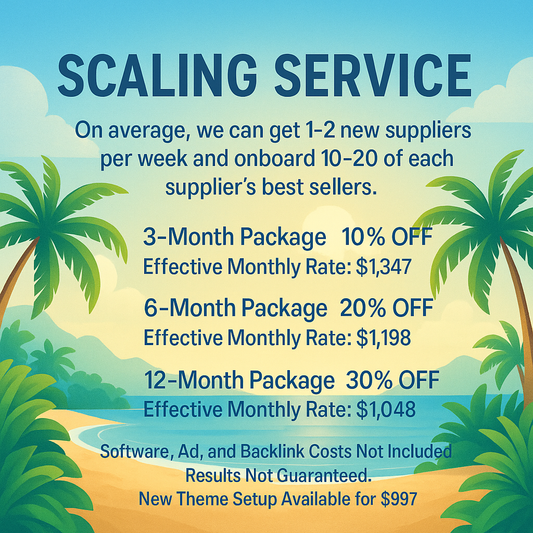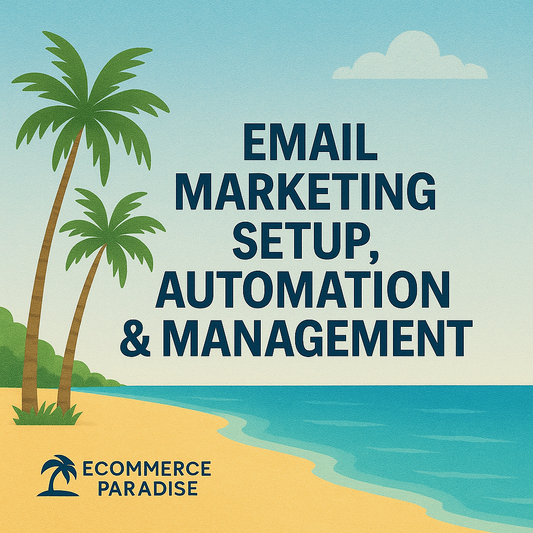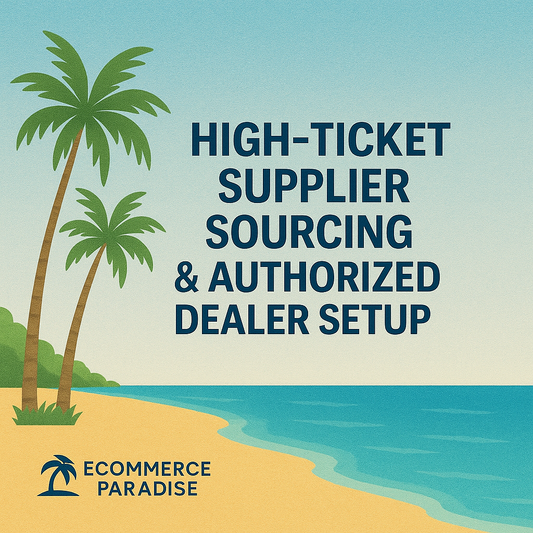
Mastering Performance Metrics to Boost Your E-commerce Store
Overview
To succeed in e-commerce, effectively track and analyze key performance metrics like conversion rate, average order value, customer acquisition cost, and cart abandonment rate. Utilize analytics tools such as Google Analytics and Shopify Analytics to gather data, optimize your strategies, and make data-driven decisions. Regularly monitor customer feedback and market trends to refine your approach, and consider A/B testing to enhance your store's performance. With the right tools and insights, you can maximize profits and build strong customer relationships in the competitive e-commerce landscape.
If you own an e-commerce store, you know that success hinges on your ability to track and analyze performance metrics effectively. In today’s competitive landscape, understanding your store's data can make or break your business. At Ecommerce Paradise, we don’t just focus on high-ticket dropshipping or high ticket ecommerce; we prioritize equipping you with the tools you need to gain insights and improve your store’s performance continuously. So let’s dive into the world of metrics and how they can guide you toward greater success.
The Importance of Performance Metrics
Performance metrics are the KPIs (Key Performance Indicators) that tell you how your e-commerce store is doing. They help you understand customer behavior, product performance, and overall business health. When you’re engaged in high ticket niches, tracking these metrics becomes even more crucial. Why? Because you want to ensure that every dollar spent on marketing returns a profit, especially when selling high-ticket items.
What Are the Key Metrics to Track?
Here are some of the essential performance metrics you should monitor religiously:
- Conversion Rate: The percentage of visitors who make a purchase is critical in determining the effectiveness of your e-commerce strategies.
- Average Order Value (AOV): This metric provides insights into the average amount a customer spends when they complete a transaction.
- Customer Acquisition Cost (CAC): The total cost incurred to acquire a customer, which informs your marketing budget and strategy.
- Cart Abandonment Rate: Knowing how many potential orders are lost can help you optimize your checkout process.
- Return on Investment (ROI): Measuring the profitability of your marketing efforts will highlight what's working and what isn't.
Understanding these metrics positions you strategically, allowing you to tweak your approach and maximize your profits, especially if you venture into dropshipping high ticket products.
How to Collect and Analyze Your Metrics
Now that we’ve covered the essential metrics, let’s discuss how to gather and analyze them effectively.
Utilize Analytics Tools
Many e-commerce platforms, including Shopify, offer built-in analytics tools that provide real-time data on your performance metrics. Here are some tools to consider:
- Google Analytics: Offers extensive tracking capabilities to understand traffic sources, user behavior, and conversion paths.
- Shopify Analytics: Built right into your Shopify dashboard, this tool offers insights tailored specifically to your store.
- Heatmaps: Tools like Hotjar visualize where customers click, scroll, and spend time on your website.
Using these analytics tools will help you streamline the monitoring process, making it easy to track and make sense of complex data.
Setting Up Monthly SEO Optimization
Many e-commerce business owners overlook the vital role of Monthly SEO Optimization in relation to their metrics. With realistic analytics, you’re empowered to improve your search engine rankings organically. By understanding which keywords lead customers to your site and how they interact with your content, you can refine your SEO strategy. This is particularly important in high ticket ecommerce, where competition is fierce.
Your SEO metrics should track:
- Organic Traffic: The number of visitors arriving from search engines is vital for gauging your visibility.
- Keyword Rankings: Monitoring how your keywords perform over time can inform your content strategy.
- Backlink Profile: Understanding who links to you and how it impacts your authority helps maintain a healthy SEO growth strategy.
Making Data-Driven Decisions
Once you have established the key metrics and tools for tracking, it’s time to translate your findings into actionable strategies. Here’s how you can utilize your data to inform your business decisions:

Target Audience Insights
Analyzing visitor demographics will help you understand your target audience better. Are you seeing a higher percentage of visitors from a specific region? Consider tailoring marketing efforts on social media platforms catering to that demographic. When you utilize a done for you ecommerce store, you can also optimize your advertisements to better match your top-performing audience segments.
Identifying High-Performing Products
Look closely at product performance metrics to identify which items are selling well and which aren’t. Understanding your AOV will help you focus on strategies to raise it, perhaps through bundling products or promoting upsells in your high ticket ecommerce offerings.
Optimize Your Email Campaigns
Email campaigns can be highly effective for re-engaging customers. Use your metrics to understand click-through rates, open rates, and conversions to refine your strategy further.
The Role of A/B Testing
A/B testing is an invaluable tool for optimizing your store. By comparing two versions of a webpage, you can discover which version performs better based on specific metrics. Here’s how to implement A/B testing effectively:
- Changing Call-to-Action (CTA): Test different wording or button colors to see what encourages more clicks.
- Variations in Product Images: Sometimes a simple image swap can make a significant difference in the conversion rate.
- Checkout Process Modifications: Experiment with simplifying the checkout process to lower cart abandonment rates.
Using A/B Testing for Done for You Dropshipping Stores
If you've opted for a done for you dropshipping store, you can easily conduct A/B tests on product pages, landing pages, and ads. This can tremendously raise your conversion potential, guiding your future investments in marketing strategies.
Monitoring Customer Feedback
Your customers can be your best source of information. Monitor reviews, feedback, and customer satisfaction metrics to better understand their needs and expectations. Here’s how to leverage customer feedback:
- Surveys: Employ surveys asking customers for their opinions on various aspects of your store.
- Product Reviews: Pay attention to what customers are saying about your products. This can help redirect your focus to high ticket niches that are truly successful.
- Product Returns: Analyze why certain products are returned to identify areas for improvement in your product selection.
Fuel Your Strategy with Trends and Competitor Analysis
Understanding the broader market is essential for any e-commerce business, especially in high ticket dropshipping. Regularly monitoring market trends will keep you ahead of the competition and enable you to adapt quickly.
Tools for Tracking Competitor Performance
There are many tools you can use to analyze competitor performance:
- SEMrush: A popular SEO tool allowing you to explore competitor keywords and ad spending.
- Ahrefs: A robust link checker that helps you analyze competitors’ backlink profiles.
- SimilarWeb: Provides insights into traffic sources and user engagement metrics.
Crafting a Winning Strategy
Now, it’s time to put everything together. Effective tracking and analysis lead to informed decision-making, which multiplies your chances of success. Setting the foundation for a successful e-commerce strategy begins with understanding these key metrics:
- Invest in the Right Tools: Utilize available analytics tools to gather data seamlessly.
- Focus on Monthly Optimization: Conduct regular checks and updates on your Monthly SEO Optimization.
- Leverage Customer Insights: Always pay attention to customer preferences to keep your inventory in line with demand.
Whether you manage a done for you ecommerce business or a bustling turnkey dropshipping store, the insights you gain from tracking your performance metrics can empower you to pivot when necessary and drive growth successfully.
Your Path to E-commerce Success Awaits!
The journey of mastering performance metrics can seem daunting at first, but armed with the right tools and strategies, it can lead your e-commerce store to new heights. Whether it’s monitoring cart abandonment or focusing on A/B testing with your done for you dropshipping website, each metric is a stepping stone towards success. Remember, in the world of high ticket ecommerce, it's not just about selling, but about building long-lasting relationships with your customers. Unlock your store's potential, and get ready to thrive in the e-commerce sphere!
Linked Product

Ecommerce SEO Service – Complete Monthly Optimization Package
The Ecommerce SEO Service offers a comprehensive monthly optimization package specifically designed for Shopify stores, ensuring tailored strategies that address the unique challenges of e-commerce. Key features include a complete technical SEO audit, on-page optimization, and ongoing keyword tracking, all aimed at enhancing visibility and driving traffic. This service is ideal for high-ticket brands looking for long-term growth without the constraints of contracts.
View Product














